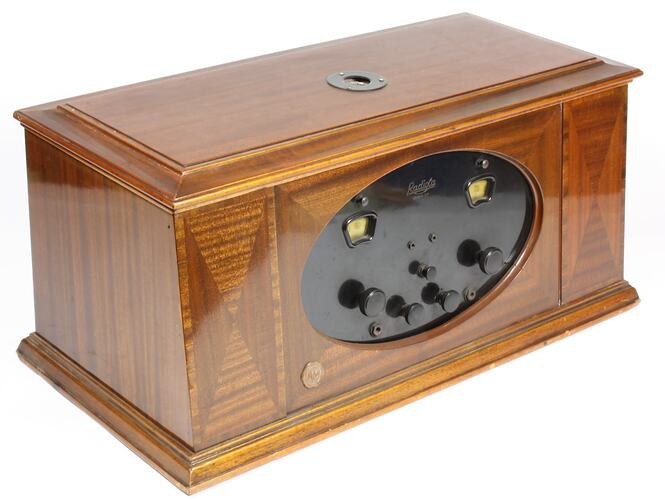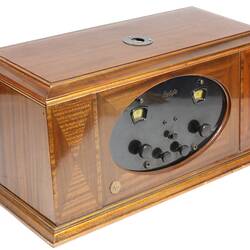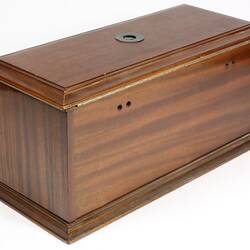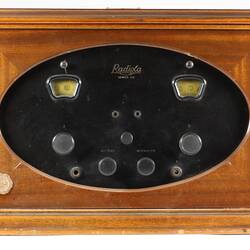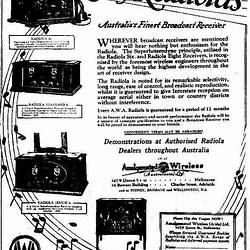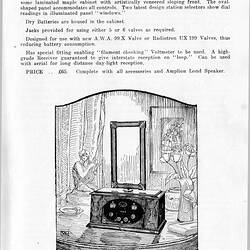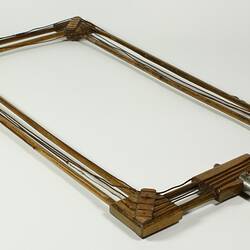Summary
This model also known as the 'Radiola Senior Six'. It was a battery powered superheterodyne receiver, using triode valves in all stages. The C38 'Standard Six' and C39 'Senior Six' were electrically the same but the later had a much higher quality cabinet with space to fit the 'B' batteries and it came with a loop aerial. The C38 cost £45 and the C39 cost £65 with speaker and accessories in both cases.
The design was the same as the contemporary RCA superheterodynes, based on Armstrong's work. To keep the valve-count down it used an RF stage reflexed with the first IF stage and a self oscillating mixer. The local oscillator frequency was half of the required value, depending on its second harmonic to mix with the input signal to produce the intermediate frequency. This technique is called 'second harmonic mixing' it was done to prevent 'pulling' of the local oscillator by the signal tuned circuit. One difference from the RCA design was that AWA added regeneration to the RF stage, controlled by a variometer style rotating coil operated by a knob labelled 'intensifier'. This set has two tuning dials, one to control the local oscillator, the other to tune the aerial circuit. For any given local oscillator frequency, two signal frequencies will be accepted, one above the local oscillator frequency and its harmonics by the IF frequency and the other below it by the same amount. The aerial tuned circuit, often called the 'pre-selector', determines which of the possible frequencies will be received.
Valves used for the RF and IF amplifier stages and the detector were type UX199, the audio amplifiers were Marconi Osram type DEP 410. Two of the UX 199s are missing.
AWA stopped making superheterodyne receivers for the domestic market in1928 and did not resume their manufacture until 1933.
Physical Description
Rectangular wooden cabinet with a hinged lid. Black front panel is framed by the wooden front of the cabinet. The front panel has two peep-hole dials marked 0 to 100 with tuning knobs below them, a pair of 4 mm sockets for connecting a meter to check the voltage applied to the filaments, two other knobs labelled 'BATTERY' and 'INTENSIFIER', a push-pull power switch in the middle of the panel and two headphone or speaker jacks at the bottom.
More Information
-
Collecting Areas
-
Acquisition Information
Donation from Amalgamated Wireless (Australasia) Ltd., 27 Nov 1975
-
Manufacturer
Amalgamated Wireless (Australasia) Ltd (AWA), Australia, 1927
-
Inscriptions
Front panel: Radiola/SENIOR SIX/A B(over each tuning knob)/BATTERY INTENSIFIER (over each other knob)/1 2 (over each output jack) Rosette on wooden part of front: AWA On the top of the catacomb inside: F387 Metal label on the inside of the lid: Radiola/SENIOR SIX/NOTICE/THIS INSTRUMENT IS/LICENCED FOR DOMESTIC OR/PRIVATE USE ONLY AND NOT/FOR ANY COMMERCIAL OR/REVENUE EARNING PURPOSE/ (List of patents)/Amalgamated Wireless A-asia Ltd. Sydney/No. C39/38
-
Brand Names
-
Classification
-
Category
-
Discipline
-
Type of item
-
Overall Dimensions
685 mm (Width), 345 mm (Depth), 313 mm (Height)
-
Keywords
